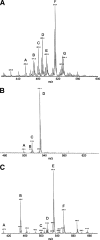Evolution of the bile salt nuclear receptor FXR in vertebrates
- PMID: 18362391
- PMCID: PMC2431107
- DOI: 10.1194/jlr.M800138-JLR200
Evolution of the bile salt nuclear receptor FXR in vertebrates
Abstract
Bile salts, the major end metabolites of cholesterol, vary significantly in structure across vertebrate species, suggesting that nuclear receptors binding these molecules may show adaptive evolutionary changes. We compared across species the bile salt specificity of the major transcriptional regulator of bile salt synthesis, the farnesoid X receptor (FXR). We found that FXRs have changed specificity for primary bile salts across species by altering the shape and size of the ligand binding pocket. In particular, the ligand binding pockets of sea lamprey (Petromyzon marinus) and zebrafish (Danio rerio) FXRs, as predicted by homology models, are flat and ideal for binding planar, evolutionarily early bile alcohols. In contrast, human FXR has a curved binding pocket best suited for the bent steroid ring configuration typical of evolutionarily more recent bile acids. We also found that the putative FXR from the sea squirt Ciona intestinalis, a chordate invertebrate, was completely insensitive to activation by bile salts but was activated by sulfated pregnane steroids, suggesting that the endogenous ligands of this receptor may be steroidal in nature. Our observations present an integrated picture of the coevolution of bile salt structure and of the binding pocket of their target nuclear receptor FXR.
Figures




References
-
- Hofmann A. F. 1999. The continuing importance of bile acids in liver and intestinal disease. Arch. Intern. Med. 159 2647–2658. - PubMed
-
- Gass J., H. Vora, A. F. Hofmann, G. M. Gray, and C. Khosla. 2007. Enhancement of dietary protein digestion by conjugated bile acids. Gastroenterology. 133 16–23. - PubMed
-
- Kalaany N. Y., and D. J. Mangelsdorf. 2006. LXRs and FXR: the yin and yang of cholesterol and fat metabolism. Annu. Rev. Physiol. 68 159–191. - PubMed
-
- Haslewood G. A. D. 1967. Bile salt evolution. J. Lipid Res. 8 535–550. - PubMed
Publication types
MeSH terms
Substances
Grants and funding
LinkOut - more resources
Full Text Sources
Molecular Biology Databases

